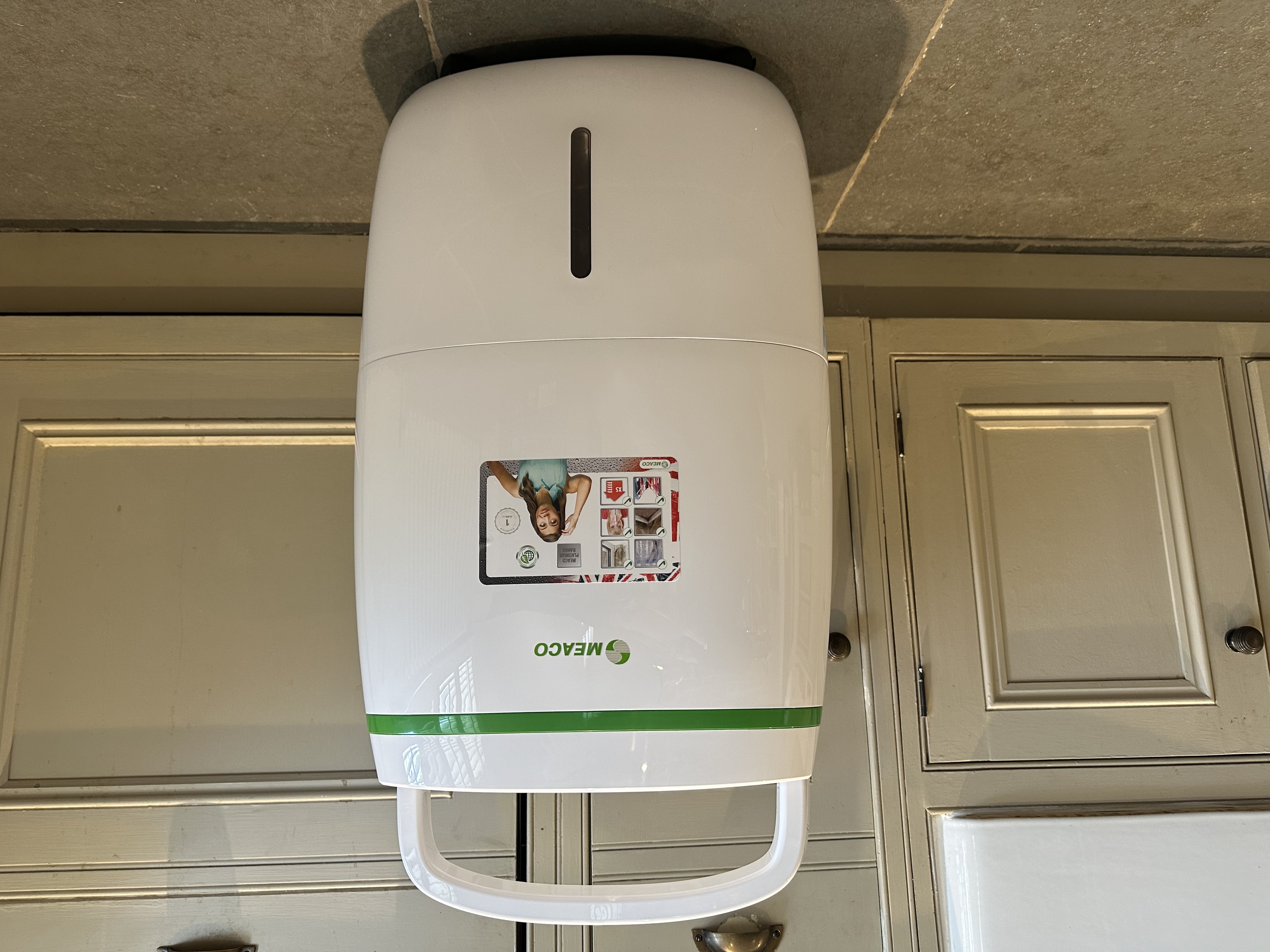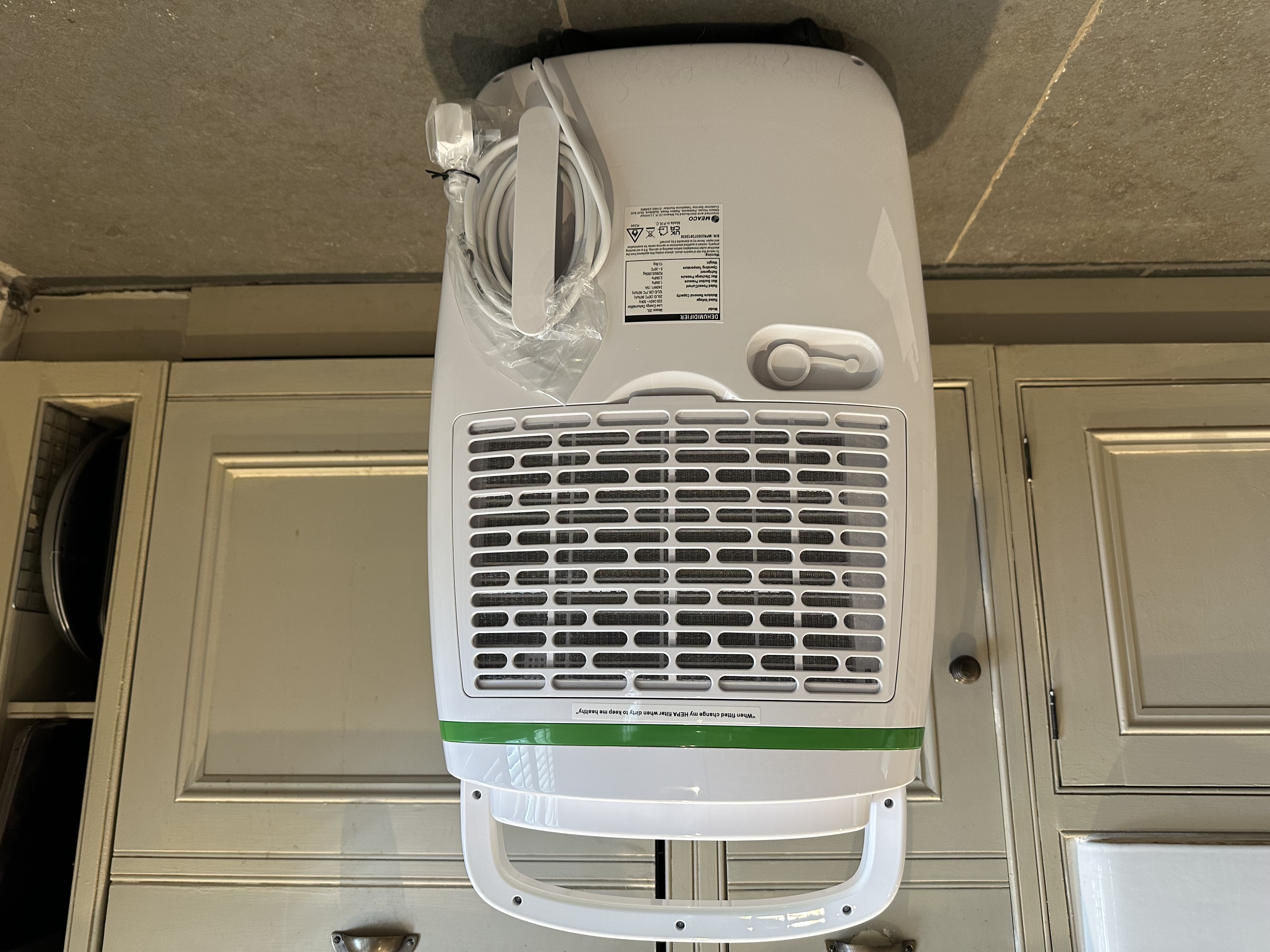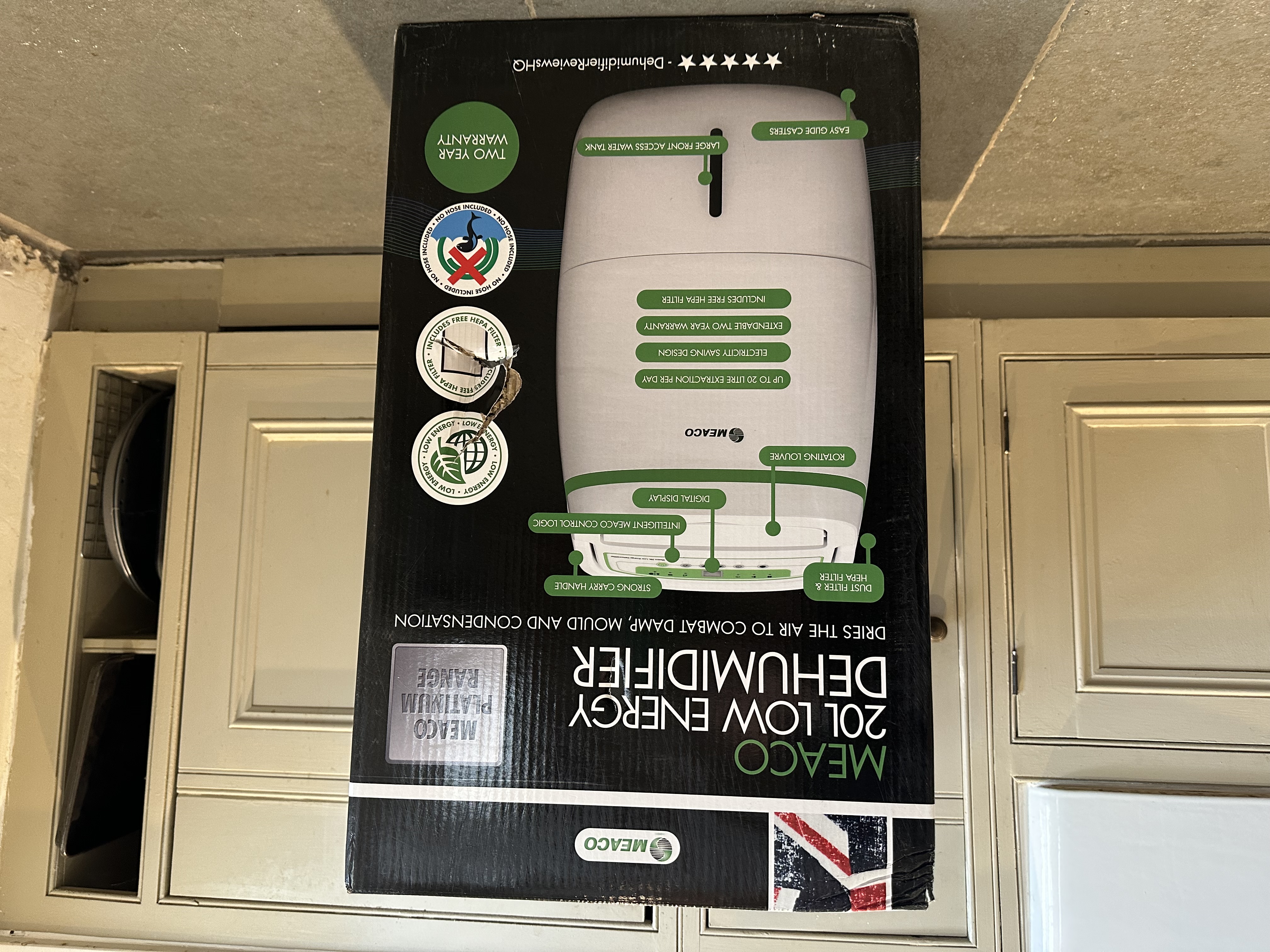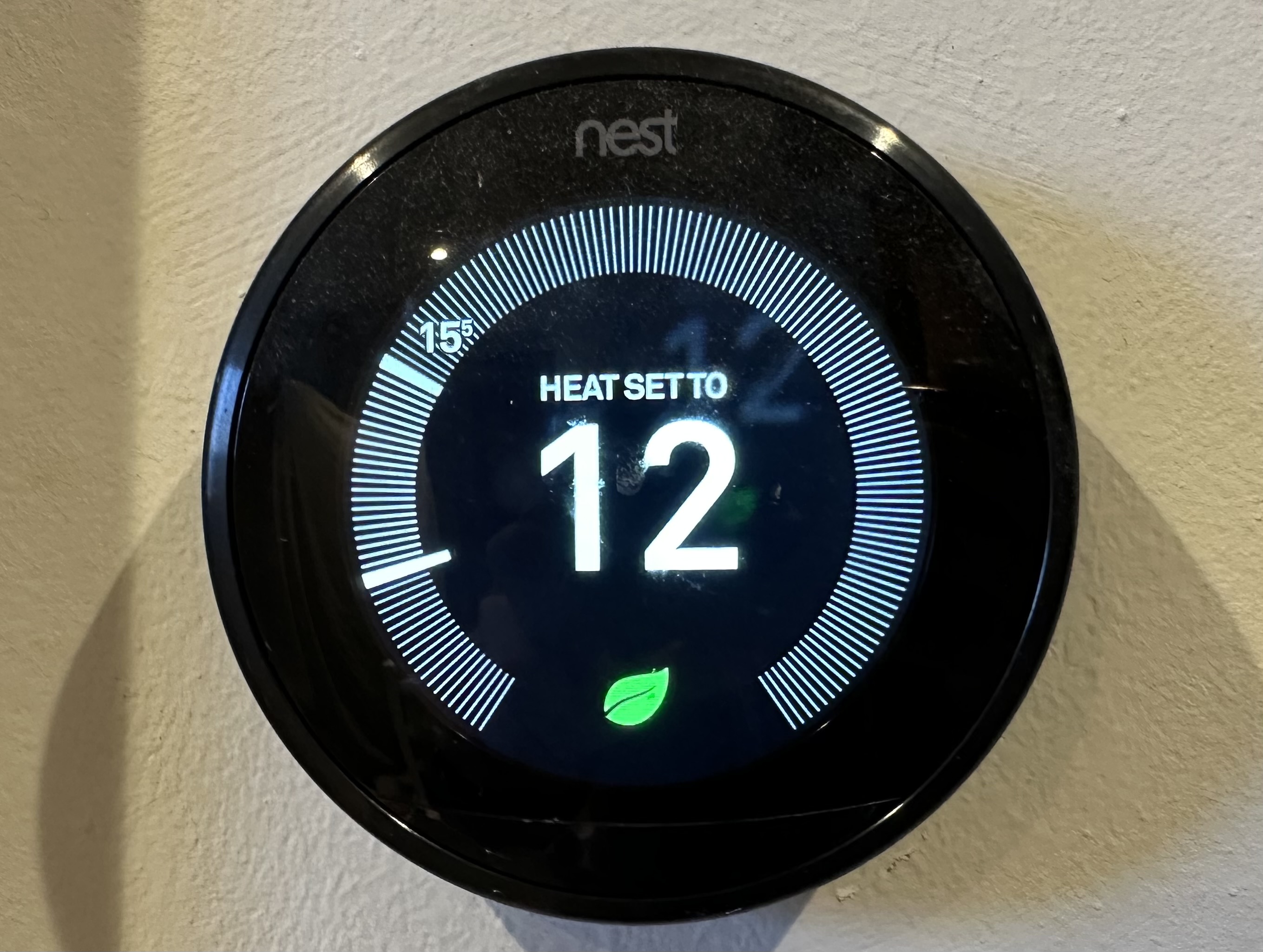I tried using a dehumidifier to save money on energy bills — here's what happened
While most dehumidifiers don't pump out heat, pulling moisture out of the air can make you feel warmer. But can this reduce the need to turn on your heating and therefore save you money on energy bills? Amy Willis puts the theory to the test

When Kevin McCloud said a cheap air conditioning trick was to mop a floor, I was intrigued.
The logic is to do with evaporative cooling, a natural process that also happens to be how air conditioning works. What happens is that as the liquid water evaporates into a gas, it uses heat in the air as an energy source. As a result, the heat loss causes the air to cool.
But it got me thinking – could similar be true with higher humidity in a house during winter? Could more water in the air make it feel colder? And. therefore, could less water in the air be a bit of an energy saving tip?
I decided to test the theory using a dehumidifier to lower the humidity levels in my home and see if it helped me keep the thermostat turned down and the central heating off, saving energy and potentially money on my energy bills.
Does high humidity in cold weather make it feel colder?
First things first, I did some investigating to see if there was any truth in this idea of higher humidity in cold weather making a room feel colder. And apparently this is true – although not, as I initially thought. It turns out that humidity levels can not alter the temperature of a room, but, while higher humidity won't change the room's temperature, it will change how warm you feel.
This is because humid air has a higher water content. This makes it more difficult for a body to keep warm because it is harder to transfer body heat to water than it is to air, a blog for Brennan's Heating and Air Conditioning explains.
"The process of moisture evaporating off your skin naturally cools you down. Your body won’t sweat when it’s cold, but humidity from the air can place moisture on your skin and give you the same chilly effect," it said.
Essentially, the warmth from your skin is being used as the energy source for evaporative cooling, which is great in hot weather but that heat loss doesn't feel so great with colder conditions.
Did running a dehumidifier make me feel warmer?
The next step was to put the science to the test. My home is a classic example of a historic cottage that generally feels cold all year around – great in summer but much less beneficial in winter. I have single glazing too, with large air gaps around the windows downstairs and large, cold stone flagstones in my kitchen, where I usually work.
To test the theory, I ran a Meaco 20L low energy dehumidifier 24/7 in my home for two weeks. I was immediately surprised to not feel cold as temperatures started to gradually drop during that time. The humidity reading on the dehumidifier came down to 55-60%rh after an initial and rather alarming reading of 88%rh. I later discovered that a high initial reading is not unusual when first turning on a dehumidifier.
As my hallway thermostat nudged 15°C, I didn't feel the need to turn the heating on or light the log burner until it dipped to 12°C. Meanwhile, overnight, I happily left the heating off all night without feeling cold getting up in the morning.
Having felt comfortable during the first two weeks of using the Meaco 20L low energy dehumidifier, I dared to switch it off overnight and into the next day to see if I noticed the difference.
And I've got to say that despite the thermostat still reading a similar temperature, a positive chilly 14°C, I felt like I was sitting in a large industrial fridge as I tried to get on with my day's work. I was not only shivering but the air felt cold inside my clothing. In fact, five minutes into my day, I gave up and switched the heating on because frankly shivering while you try to type is not a lot of fun. Switching the dehumidifier back on, it was reading around 72%rh so I do put this discomfort down to the humidity level rising back up.

How expensive was the dehumidifier to run?
The cost of running the dehumidifier 24/7 does of course come with a price tag, and this was something I was conscious of throughout the experiment.
Dehumidifier running costs do vary between models but the Meaco 20L low energy dehumidifier that I was using has a power consumption of 219 watts at 20°C and 60% relative humidity.
With the energy price cap standing at 27p per kWh, from 1 October to 31st December 2023, this put the running cost of the dehumidifier at 5.9p an hour (0.219kWh x 27p = 5.9p).
So for 24 hours worth of use, the dehumidifier cost me £1.42, and for 14 days of use 24/7 it cost £19.88. However, that's not taking into account the dehumidifier automatically shutting off when it reached the desired humidity of 55%rh or when the 20L tank became full. It's also worth pointing out that my house is particularly leaky so a more modern, well insulated house is likely to only need the dehumidifier on for perhaps 12 hours rather than 24 hours like I was running it.
Were there other benefits to running the dehumidifier?
During the two weeks running the Meaco 20L low energy dehumidifier, I also stopped needing to use my tumble dryer. Instead, I could set up a clothes horse in the kitchen near the dehumidifier and be confident that the items would be dry by morning.
Prior to the dehumidifier, clothes would often take a good two or three days to dry like this, making the tumble dryer essential to avoid musty smelling socks and tops.
I have a condenser tumble dryer, so my tumble dryer running cost is around £1.44 a full load (based on an estimated 5.34kWh wattage) meaning that running the dehumidifier did save me money on this. To put a figure on this, I was using the tumble dryer about three times a week without the dehumidifier at an estimated cost of £8.64 over a two week period. With the dehumidifier running, I only used it once (due to speed mainly) costing me £1.44.
The other benefits were difficult to put a value on but included reducing condensation on the windows upstairs (downstairs the huge gaps sort this out) as well as reducing any chance of mould taking up residence in the home. This particular dehumidifier also has an air purifier on it too, which given that I live next to a busy road, I felt was a nice added bonus.

Did the dehumidifier save me money on energy bills?
Running the dehumidifier 24/7 for two weeks cost me an estimated £19.88 in energy.
Working out the saving on central heating was a little more tricky, as I generally put more jumpers on, light the log burner and try to endure the cold rather than turning the heating on in the days before using the dehumidifier. This of course isn't helpful when trying to draw a comparison, however, looking back at my Nest report for November 2022, I used 97 hours of heating, which works out at three and a half hours a day or 46.2 hours for two weeks.
Meanwhile, over the two-week period running the dehumidifier, looking at my Nest report, I used an average one-and-a-half hours a day of central heating, which worked out as roughly 22 hours of heating for two weeks — under half the amount.
With central heating costs per hour based on an average 10,000kWH usage an hour, boiler running costs are 8p an hour with both gas or oil, based on the current energy price cap gas rate of 7p per kWh and an oil price of 77p per litre.
Therefore with tumble dryer costs, central heating costs and dehumidifier running costs considered, my energy cost without the dehumidifier was a total of £12.34 — £3.70 in oil central heating and £8.64 in tumble dryer costs.
Meanwhile, my energy costs with the dehumidifier running were a total of £23.08 — £19.88 for the dehumidifier, £1.76 for oil central heating, and £1.44 for the tumble dryer.
Essentially the dehumidifier cut my energy usage by a half, but despite this, did not reduce my energy bills.

Will I keep using the dehumidifier?
Interestingly and perhaps surprisingly, based on current energy prices, running the dehumidifier did not save me any money on my energy bill. It cost me more.
That said, if the price of oil and gas went up and the price of electricity went down, this might become more of a saving than a cost, as running the dehumidifier definitely reduced my energy usage, not to mention feeling much warmer and comfortable while working from home.
Ultimately, however, the additional cost to run the dehumidifier — taking into account my energy savings (mainly on the tumble dryer) — was £10.74 for the two-week period. For that price, I will definitely be continuing to run it. Not only to feel warmer while working from home but for drying laundry and getting rid of that condensation upstairs.
Get the Homebuilding & Renovating Newsletter
Bring your dream home to life with expert advice, how to guides and design inspiration. Sign up for our newsletter and get two free tickets to a Homebuilding & Renovating Show near you.

Amy spent over a decade in London editing and writing for The Daily Telegraph, MailOnline, and Metro.co.uk before moving to East Anglia where she began renovating a period property in rural Suffolk. During this time she also did some TV work at ITV Anglia and CBS as well as freelancing for Yahoo, AOL, ESPN and The Mirror. When the pandemic hit she switched to full-time building work on her renovation and spent nearly two years focusing solely on that. She's taken a hands-on DIY approach to the project, knocking down walls, restoring oak beams and laying slabs with the help of family members to save costs. She has largely focused on using natural materials, such as limestone, oak and sisal carpet, to put character back into the property that was largely removed during the eighties. The project has extended into the garden too, with the cottage's exterior completely re-landscaped with a digger and a new driveway added. She has dealt with de-listing a property as well as handling land disputes and conveyancing administration.
